
Dysphoria – Wanting Reality to be Different Than It Is
The Desire for a Life Different Than Our Own
Primary Category: Anthropology / Philosophy
Author:
• Tim McGuinness, Ph.D., DFin, MCPO, MAnth – Anthropologist, Scientist, Polymath, Director of the Society of Citizens Against Relationship Scams Inc.
Author Biographies Below
About This Article
Dysphoria is presented here as the near-universal condition of wanting reality to be different than it is, a pattern that likely intensified when religion introduced ideals that measured ordinary life against something better. The thesis explains how modern systems deepen this dissatisfaction: schools train the belief that one is incomplete until one becomes something, marketing sells permanent lack, social media curates envy, and scammers exploit the longing for romance, wealth, and status. The psychological costs are substantial, including diminished self-esteem, anxiety, depression, identity instability, burnout, debt, strained relationships, and a persistent sense of existential emptiness. The body becomes a prime battleground through appearance pressures, cosmetic industries, and porn’s idealized intimacy, with body dysmorphia as an intensified endpoint and chronic stress burdening the nervous system. Cultural stories, films, and influencer narratives keep the fairy-tale chase alive, while philosophical and religious traditions, Abrahamic, Asian, Aztec, and Native American in contrast, show how striving has been framed as duty, transcendence, balance, or sacrifice. Dysphoria functions as both driver and destroyer, powering innovation and art while feeding greed and restlessness. Radical acceptance in Buddhist practice offers a counterpoint, suggesting peace through wanting less and inhabiting what is. The practical resolution invites moderation: hold aspiration and acceptance together so dysphoria informs growth without defining identity or leaving one vulnerable to manipulation.
Note: This article is intended for informational purposes and does not replace professional medical advice. If you are experiencing distress, please consult a qualified mental health professional.

Dysphoria – The Desire for a Life Different Than Our Own
Editor’s Note
This work presents an original thesis developed by Tim McGuinness, Ph.D., Anthropologist and Polymath, who has researched the condition and concept of dysphoria for more than forty years. The perspective offered here differs from common medical/psychological explanations. It expands beyond the idea of dysphoria in a narrow clinical definition, framing it instead as a fundamental characteristic of modern human life for at least the last 6,000 years.
The central observation in this article is that dysphoria is the principal defining feature of modern humans, for whom dysphoria is nearly universal, and our ancient ancestors, for whom it apparently did not exist in the same way. Early human communities lived with no real choices in their lives. Their daily focus was survival, hunting, gathering, securing shelter, and reproducing. Within this context, there was no real room for imagining a life different than the one at hand. They may have faced hardship, but they lacked the cultural frameworks that encourage constant longing for something else.
The thesis argues that dysphoria emerged with the invention or recognition of religion. When humans began to conceive of gods, ideals, and higher purposes, they also began to measure themselves against these unseen standards. Religion introduced the concept of becoming more than one currently is: better, purer, holier, or more worthy. From that moment forward, human beings carried the burden of wanting life, identity, and reality to be different from what they actually were. This marked the beginning of dysphoria as a defining feature of human consciousness. And with it came the great evils of our world: want, desire, greed, envy, jealousy, and the hate that springs from these.
By understanding dysphoria back to this cultural and spiritual turning point, this work seeks to explain why dissatisfaction runs so deeply in modern existence and why it may be inseparable from the way societies now structure meaning and purpose.
Why does this matter in the context of scams? Because dysphoria is the overriding vulnerability that every scammer exploits.
Dysphoria
by Prof. Tim McGuinness, Ph.D., DFin, MCPO, MAnth …
Defining Dysphoria
Dysphoria can be understood most simply as the condition of wanting reality to be different from what it is. It is the unsettling awareness that life as it currently exists does not match what a person believes it should be. This experience is not confined to moments of hardship or failure. It is woven into the very fabric of human consciousness. People wish their lives were different in countless ways, from the grand to the trivial. They want more security, more recognition, more beauty, more love. In short, dysphoria is dissatisfaction made visible in the mind.
It is useful to contrast dysphoria with its linguistic opposite, euphoria. Euphoria is the condition of alignment, when reality and expectation seem to merge, leaving a person feeling uplifted or elated. Euphoria is fleeting, often dependent on circumstances that cannot be sustained. Dysphoria, in contrast, is more persistent. It gnaws at daily life, arising whenever one compares what is with what could be or should be. In this sense, dysphoria is not merely an emotional state but a reflection of the deep rift between existence and desire.
Medical and psychological literature defines dysphoria more narrowly than this broad human experience. In clinical usage, it often refers to distress linked to specific conditions.
Example recognized disorders include:
- Gender dysphoria, the distress caused when a person’s gender identity does not align with the sex assigned at birth.
- Premenstrual dysphoric disorder, an intense mood disturbance tied to hormonal cycles.
- Postictal dysphoria, a state of irritability or depression following seizures.
- Dysphoria is associated with depression, bipolar disorder, or anxiety disorders.
These clinical definitions serve a purpose, identifying specific kinds of suffering that demand medical or therapeutic attention. Yet focusing only on these disorders risks missing the larger truth: nearly everyone knows dysphoria in one form or another.
It is not limited to people who meet diagnostic criteria. In fact, modern life almost ensures that everyone carries some form of discontent. A person wants a better job than the one they have. Another longs for a more fulfilling relationship, or feels let down by the partner already chosen. Parents dream of children who behave differently, achieve more, or reflect more favorably on the family. Others desire a larger house, a newer car, or greater wealth to confirm their sense of worth. The wish to look better, feel stronger, or even change one’s body entirely is increasingly common. At the core of these longings is the belief that the self as it stands is incomplete.
Dysphoria is therefore not an exception to the human condition but its common rule. People live surrounded by a stream of imagined possibilities, often failing to embrace what already exists. They compare themselves against images of who they could be or who they feel they should be, and the distance between those images and their reality produces the quiet, ongoing unease of dysphoria. The central theme emerges clearly: humanity rarely accepts what is. Instead, it hungers for what is not yet, for what might never be. This constant tension defines not only individuals but whole societies, pushing them forward while also leaving them perpetually unsettled.
The Universal Experience of Dysphoria
Dysphoria is not a rare or unusual condition. It touches nearly every person, in every society, and in nearly every stage of life.
It may appear subtle, hidden beneath the routines of daily living, yet its influence is constant. A person may wake in the morning and immediately begin thinking of what is lacking, what they do not yet have, what they wish were different, or what they believe should improve. This restless gap between reality and expectation is what defines dysphoria. It is not an occasional thought but an ongoing undercurrent shaping identity, relationships, and aspirations.
Consider the workplace, where dissatisfaction is perhaps most visible. Many people feel trapped in jobs that do not fulfill them, longing for a promotion, a higher salary, or more recognition. Even those who succeed often find the achievement temporary, as soon another position or opportunity becomes the new target. The desire for something better never fully subsides. Instead, it drives individuals into cycles of ambition that are difficult to escape. The sense of not being enough in one’s current role becomes a steady companion.
Relationships reflect the same pattern. A person may long for a different spouse or partner, convinced that happiness lies elsewhere. Even within marriages or long-term commitments, people may quietly imagine how life would be improved if only their partner were more attentive, more supportive, or more aligned with their needs. Divorce is often the outcome of this longing, with each party believing that somewhere else the right relationship waits. Children, too, become the subject of this quiet dysphoria. Parents dream of different behaviors, greater accomplishments, or personalities that reflect more positively on themselves. These wishes often begin as encouragement or guidance, but can quickly turn into chronic disappointment when reality does not match the imagined child.
Material life provides endless opportunities for dysphoria to flourish. Homes feel too small, cars too old, wardrobes too plain. People look at their possessions and measure them against those of their neighbors, colleagues, or the images presented by the media. The hunger for more wealth or status is rarely about survival. It is about recognition, the belief that a larger house or a better car will not only improve comfort but confirm value and identity. When that recognition fails to materialize, the sense of insufficiency deepens.
Even the body itself becomes a field where dysphoria takes root. Many people look in the mirror and wish to change what they see. They want to be thinner, stronger, younger, or more attractive. The entire health and beauty industry is built on this dissatisfaction, offering diets, surgeries, and endless products to address the longing for a body that feels different than the one that exists. The desire is rarely minor. It shapes self-esteem, affects relationships, and often dictates choices about money, health, and time.
Dysphoria also extends into less visible territories. People want to be more important, more respected, more admired. Titles, awards, and influence all serve as symbols of worth. The absence of these often leaves individuals feeling small or overlooked, even when their lives are otherwise stable. This form of dysphoria is powerful because it strikes at identity. It is not about possessions or appearances but about the core question of who one is in relation to others.
What makes these desires particularly significant is that they are not occasional frustrations. They are consistent forces shaping the trajectory of human life every minute of every day. People relocate, end marriages, change careers, take on debt, or even harm their bodies in pursuit of a reality they believe will match what they want. Dysphoria, in this sense, is not background noise. It is the fuel that drives many of the most important decisions individuals make.
Often, dysphoria does not announce itself by name. Instead, it disguises itself as ambition, improvement, or hope. Society rewards those who are never satisfied, calling them driven, motivated, or visionary. Children are told to strive for more. Adults are praised for chasing bigger goals. The constant desire for a different reality is reframed as progress. Yet beneath this positive language lies the same restless dissatisfaction that has always defined dysphoria. The impulse to improve is not inherently harmful, but when it is rooted in rejection of the present self, it becomes an endless cycle of pursuit without peace.
In this way, dysphoria proves to be universal. Everyone knows what it means to want life to be different. Everyone has felt the tension between what is and what should be. It is not a fleeting thought but a shared human experience, one that shapes the course of individual lives and the structures of entire societies.
Dysphoria in Modern Life
Modern life does not simply tolerate dysphoria. It cultivates it.
From early childhood, people are shaped to believe that who they are is not yet enough and that worth comes only after becoming something more. Schools, media, marketing, and digital platforms all participate in reinforcing this cycle, leaving individuals surrounded by constant reminders that their lives fall short of an imagined ideal.
Education provides one of the earliest examples. Children enter school and are taught not only to read, write, and calculate but also to internalize a message: they are incomplete until they succeed. Grades, awards, and rankings send the signal that their current state is insufficient. The entire structure is future-oriented, built on the promise that with enough effort, a child can become a valuable adult. The result is that from the first years of life, many grow accustomed to believing that their present self is not worthy of acceptance. Schooling, while essential for knowledge and skills, indoctrinates and embeds this subtle dysphoria deep within the psyche.
Marketing then takes hold of this vulnerability. Advertisements rarely appeal to contentment. Instead, they thrive by whispering that life is missing something. A person sees an image of a smiling family in a new car and feels their own vehicle is inadequate. A commercial shows a perfect body in designer clothes and plants the idea that their current appearance is unworthy. Even products meant to solve everyday problems often carry an underlying message: without this purchase, one’s life is lacking. The strategy is consistent across industries. Marketing does not just offer goods and services. It sells dissatisfaction as a way of life, making people believe they are always one step behind where they should be.
Social media amplifies this process to an unprecedented degree. Platforms designed for connection become stages for comparison. People see curated images of vacations, relationships, and achievements, then measure their own lives against these polished fragments. The gap between reality and perception widens, producing collective dysphoria. Even when someone knows intellectually that social media shows only highlights, the emotional impact is hard to resist. The result is a culture in which millions of people silently feel less attractive, less successful, and less worthy than their peers. The very idea of celebrities and influencers is to exploit this dysphoria to push an agenda.
Scammers exploit the same vulnerabilities. They understand that most people carry a quiet longing for more, more love, more wealth, more recognition. Romance scams, investment frauds, and fake job offers all depend on convincing individuals that what they want but do not yet have can be delivered. The scammer presents the missing piece: the perfect partner, the once-in-a-lifetime opportunity, or the financial breakthrough that promises freedom. Victims, already living with dysphoria, often accept these illusions because they align so closely with the life they wish were real. In this way, fraud is not random. It is built upon the universal dissatisfaction that modern systems cultivate and reinforce.
Taken together, schools, marketing, social media, and scams reveal how modern life is structured around constant discontent. Instead of teaching acceptance of the present self, society promotes the idea that fulfillment always lies in the next stage, the next purchase, or the next relationship. The result is a population conditioned to chase what they do not yet have, often at great emotional and psychological cost. Dysphoria becomes not just an individual struggle but a cultural norm, shaping collective behavior as much as personal identity.
The Psychological Cost of Dysphoria
Dysphoria is more than a quiet background thought. When left unchecked, it creates a deep psychological burden that influences the way people see themselves and live their lives. The wish to be different than one is, to have more than one has, or to become something beyond what already exists, does not stay in the mind as a harmless dream. It carries emotional weight and leads to patterns that damage well-being. The more one feeds this dissatisfaction, the harder it becomes to find stability in the present.
Emotional Burdens of Constant Wanting
The most immediate cost of dysphoria is emotional unrest. People who continually compare their lives to what they believe they should be experience ongoing stress and unease. A person who imagines a different body, a better spouse, or a higher salary rarely enjoys peace with what they already possess. Each day is tinged with the discomfort of lacking, even when their life holds many good things. This constant wanting erodes the ability to appreciate moments as they are.
It also leads to a pattern of restlessness. When a goal is reached, the satisfaction fades quickly, and a new desire takes its place. The person who once longed for a promotion soon begins dreaming of another. The one who desired a new house then imagines a larger or more beautiful one. This cycle leaves individuals living in a permanent state of dissatisfaction. Instead of resting in accomplishment or gratitude, they are pulled forward by the next imagined improvement.
Effects on Self-Esteem, Depression, Anxiety, and Identity
Dysphoria has direct effects on mental health. Self-esteem often suffers when people measure themselves against an imagined ideal. The belief that one is never enough reinforces feelings of inferiority. For many, this transforms into depression, where the sense of being incomplete deepens into hopelessness. The constant failure to match reality with desire produces exhaustion that feels heavier over time.
Anxiety is another natural consequence. When people always think about what they lack, they anticipate the future with fear or urgency. They worry about how to become different, how to change their situation, or how to reach the goals that feel out of reach. The body remains tense, the mind alert, as if something essential is missing that must be pursued immediately. This state of unease often becomes chronic, shaping personality as much as mood.
Identity also suffers from dysphoria. When people build their sense of self around what they are not yet, they struggle to know who they truly are. A person who always sees themselves as incomplete cannot form a stable self-image. Their identity shifts depending on the desire of the moment, whether it is wealth, recognition, or beauty. Over time, this leaves them feeling hollow, as though they exist only in relation to what is missing.
Dysphoria’s Link to Burnout, Consumer Debt, Divorce, and Dissatisfaction
The consequences of dysphoria extend far beyond individual emotion. It influences choices that shape entire lives. In the workplace, the desire to be more successful or important often drives people to overwork. They accept long hours, impossible deadlines, and constant pressure in pursuit of the next stage of recognition. The result is burnout, where physical and mental exhaustion combine to break down health and relationships.
Consumer debt also grows out of dysphoria. Advertising convinces people that their lives will improve with the right purchase, and many borrow money to meet this imagined standard. Credit cards, loans, and mortgages become tools not only for survival but for chasing the dream of a different self. When reality does not deliver the happiness expected, debt remains as both a financial and emotional burden.
Relationships are not spared. Marriages and partnerships often collapse under the weight of dysphoria. A spouse may believe happiness lies with someone else or imagine that their partner should be different in ways that can never be achieved. Divorce frequently follows, leaving both parties searching again for the fulfillment that never seems to last. Even friendships can falter when people constantly compare themselves to others, feeling inadequate or resentful of differences.
Existential dissatisfaction is perhaps the heaviest cost. At a certain point, many realize that no matter how much they achieve or acquire, the sense of incompleteness persists. This recognition leads to deeper questions about purpose and meaning. Why strive if the result never satisfies? Why live if life is always measured against an unreachable standard? For some, these questions lead to despair, where even the act of living feels empty.
The Cycle of Pursuit and Rejection of the Present
The most destructive feature of dysphoria is its cyclical nature. The more a person pursues difference, the less they can accept the present. Achievements do not resolve the longing. They only reinforce the habit of reaching beyond what is. Each success becomes proof that one must chase the next. Over time, the present moment becomes a place to escape rather than to embrace.
This cycle explains why so many people live lives of quiet frustration even when surrounded by comfort and opportunity. The restless desire for what is not yet makes it impossible to see what already is. A person with a loving family may still feel dissatisfied because their house is too small. Another with financial security may feel empty because their career lacks prestige. In each case, dysphoria blinds them to the reality of what they have, creating the illusion that life is always elsewhere.
Breaking this cycle requires more than achieving goals or acquiring possessions. It requires the courage to recognize the pattern itself and to question whether fulfillment truly comes from becoming different. Without this recognition, dysphoria remains in control, pulling people away from peace and into endless dissatisfaction.
Dysphoria and the Body
The body is one of the most visible arenas where dysphoria takes hold. Many people look in the mirror and see not what is, but what they believe should be. They notice flaws that may not exist or magnify small imperfections into defining features. This dissatisfaction can take many forms: a desire to be thinner, more muscular, younger, or more attractive. It may extend further, with some wishing to alter their very identity, reshaping the way they appear to the world in pursuit of alignment with an inner image that feels missing or incomplete.
Entire industries thrive on this longing. Gyms, diets, cosmetic companies, and surgical clinics form a billion-dollar network dedicated to feeding the dissatisfaction people feel about their bodies. Fitness programs promise transformation, suggesting that current forms are not acceptable. Diet culture reinforces the belief that the body is never quite right, always in need of improvement. Cosmetic industries sell endless products to smooth, color, or conceal, framing ordinary features as problems requiring correction. Surgery takes this even further, offering permanent alterations that claim to deliver the body a person wishes for, rather than the one they have, ignoring the physical and psychological risks.
None of these industries could survive if people accepted their bodies as they are. They depend on the persistence of dysphoria. Every advertisement emphasizes lack, telling people they are too heavy, too plain, too old, or too weak. The message is always the same: life would be better if only the body were different. This cycle ensures that dissatisfaction remains constant because even when one goal is met, such as losing weight or building muscle, another emerges immediately. The perfect body always lies just out of reach, defined by shifting cultural ideals and unreachable standards.
The porn industry extends this cycle into sexuality and relationships. It projects idealized versions of sex with flawless partners, creating unrealistic expectations of performance, appearance, and intimacy. Viewers absorb these images and often compare them to their real relationships, which rarely measure up. This expands dissatisfaction not only with one’s own body but also with partners, poisoning intimacy with unspoken comparisons and silent resentments. In this way, even private relationships become subject to the endless pressure of dysphoria.
In some cases, this discontent sharpens into body dysmorphia, an intensified form of dysphoria where perception itself becomes distorted. A person with body dysmorphia may fixate on a single feature, believing it to be grotesque or unacceptable, even when others see nothing unusual. The distress is not limited to fleeting thoughts but becomes overwhelming, consuming daily life and shaping behavior. This reveals the extreme endpoint of body-related dysphoria: a state where reality and perception are so divided that identity itself suffers.
The costs are not only psychological. The body carries the burden of this dissatisfaction through stress on the nervous system. When people live in constant tension with their physical selves, their minds and bodies remain on high alert. Anxiety about appearance activates stress responses that affect sleep, digestion, and cardiovascular health. Each glance in the mirror becomes a trigger, reinforcing a loop of negative emotions that drains both mental and physical energy. Over time, the nervous system adapts to this stress as if danger were always present. The body lives in survival mode, even though the threat is only imagined imperfection.
Dysphoria and the body are inseparable in modern life. People are rarely encouraged to accept their physical form. Instead, they are urged to alter, improve, or conceal. The pursuit of change may bring temporary satisfaction, but it rarely resolves the deeper discontent. The longing remains, reminding people that the problem is not only in the mirror but in the restless gap between who they are and who they wish to be.
The Human Condition: Wanting a Fairy Tale
Human beings have always been drawn to stories of lives more extraordinary than their own. The longing for a fairy tale life is not a modern invention, but modern systems (Hollywood and Disney) have perfected how to sell it. Marketing, influencers, and scammers all rely on this desire. They promise a version of reality that glitters with fantasy, whether it is the perfect romance, the effortless wealth, or the dream life of constant happiness. The appeal lies not only in the possibility of gaining more but in the deeper wish to escape the limits of ordinary existence.
Literature and film provide a long history of this yearning. Fairy tales, myths, and legends have shaped how people imagine what life could be. Stories of princes and princesses, of heroes rising from nothing to greatness, of lives transformed by magic or fortune, all present a vision of existence far removed from daily struggle. These narratives are not confined to childhood. They remain present in modern novels, films, and television, where characters achieve love, power, and wealth in ways that feel both impossible and tantalizing. People consume these stories knowing they are fiction, yet the images remain, feeding the quiet conviction that their own lives should look more like these fantasies. Even our holy texts are full of them.
Hollywood has played a particularly powerful role in this process. For decades, films have presented idealized relationships, glamorous lifestyles, and characters who always seem to find resolution in the end. The romantic comedy assures viewers that love will arrive, often in a dramatic and unlikely fashion. Action films tell stories of ordinary people transformed into heroes. Even dramas reinforce the idea that life carries hidden meaning waiting to be uncovered. Audiences leave theaters not only entertained but often dissatisfied with their own realities, which feel dull by comparison.
Modern influencers continue this work in digital form. On social media, lives are curated to appear like fairy tales. Vacations, celebrations, and personal achievements are displayed as though they represent daily reality. Followers see these images and imagine that others are living stories filled with constant excitement and success. In truth, these portrayals are as fictional as films, carefully edited and designed to inspire envy and generate profit. Still, they reinforce the belief that ordinary life is not enough and that others have already found the fairy tale existence that remains out of reach.
Scammers take this desire to its most dangerous conclusion. They present fantasies directly to their victims, offering romance with the perfect partner, opportunities for quick wealth, or careers that promise freedom from ordinary struggles. Victims accept these promises not because they are foolish but because they resonate with a wish that has been cultivated by culture all along. The dream of escape feels real because people already live with dissatisfaction, already believe in stories of transformation, and already want to believe that life could resemble the tales they have been told since childhood.
When you’re fast asleep.
In dreams, you will lose your heartaches,
Whatever you wish for, you keep.
Have faith in your dreams and someday
Your rainbow will come smiling through.
No matter how your heart is grieving,
If you keep on believing,
The dream that you wish will come true.
At the heart of this longing lies a deeper rejection of the ordinary self. People are not only reaching for external improvements; they are trying to flee from who they are in the present. The self feels incomplete, too plain, too bound by limits. A fairy tale life offers more than new possessions or status. It offers a chance to become someone different. This desire to escape is what gives these fantasies their power. They do not simply sell new products or experiences. They sell new identities, convincing people that happiness requires leaving behind who they are today.
When you wish upon a star
Makes no difference who you are
Anything your heart desires
Will come to you
If your heart is in your dream
No request is too extreme
When you wish upon a star
As dreamers do
Fate is kind
She brings to those who love
The sweet fulfillment of
Their secret longing
Like a bolt out of the blue
Fate steps in and sees you through
When you wish upon a star
Your dreams come true
The problem with this pursuit is that it almost never resolves the dissatisfaction it is meant to cure. Even when aspects of the fantasy are achieved, they often fail to deliver the transformation imagined. A person may gain wealth but still feel unfulfilled. They may find romance but discover that the relationship cannot live up to the idealized story in their mind. They may achieve recognition only to realize that the feeling of worth is temporary. The longing persists, always pushing them toward another version of the fairy tale that seems just out of reach. The is a psychological condition called ‘Imposter Syndrome’ for this.
The human condition reveals itself clearly in this pattern. To want a fairy tale is to want life to escape its ordinary shape. Yet the ordinary self is the only self that exists. By rejecting it, people chase illusions that deepen dissatisfaction rather than relieve it. Fairy tales, marketing campaigns, influencer images, and scam promises all point toward a single truth: the more a person longs to live in a story that is not their own, the more estranged they become from the life they actually have.
Philosophical and Religious Roots of Dysphoria
The roots of dysphoria reach far deeper than marketing or modern culture. They lie in the human ability to imagine, to compare, and to dream of “something better.” Once people became aware of possibilities beyond survival, the seeds of dissatisfaction were planted. Religion, philosophy, and even secular worldviews have all reinforced this impulse, framing human life as a journey of striving, improvement, and transformation. To understand dysphoria fully, one must look to its ancient origins and ask whether it is not only cultural but an inevitable outcome of human consciousness itself.
Primitive Humans and the Absence of Options
In the earliest stages of human existence, life was shaped almost entirely by survival. Primitive communities lived within narrow boundaries. Food had to be found, shelter secured, and threats avoided. There was no time or cultural structure to imagine radically different lives. A person’s role was largely determined by birth and the skills acquired within their group. A hunter hunted, a gatherer gathered, and a caregiver raised children.
Dysphoria, as it is understood and defined herein, had no place in such a world. Longing for a different body, a higher social rank, or a more luxurious existence would have been meaningless. The focus was immediate: staying alive from day to day. While primitive humans no doubt experienced suffering and grief, they did not have the cultural scaffolding that encourages people to see themselves as incomplete. Without the concept of choice and without the idea of becoming more than what one already was, dissatisfaction had no ground to grow.
Religion and the Birth of Aspiration
The turning point came with religion. When humans began to conceive of gods and higher powers, they also began to measure themselves against standards they could not reach. Religion introduced the idea that life as it is is not enough, that there exists a greater purpose or higher calling. This was both liberating and burdensome. On one hand, it gave people meaning and direction. On the other hand, it seeded the conviction that who they were in the present moment was unworthy.
To please the gods, humans had to change. They had to become purer, holier, more obedient, or more virtuous. Sacrifice, ritual, and law were designed not only to honor divine beings but also to shape human behavior toward ideals. This process made dysphoria a permanent feature of the human mind. No longer was survival enough. One now had to live for something beyond survival, something always just out of reach.
The Role of the Abrahamic Faiths
Christianity, Judaism, and Islam each reinforced this framework in distinct but related ways.
Judaism introduced the idea of covenant, where human beings must live up to divine laws and expectations. The relationship with God was one of striving, of constantly aligning one’s life with a higher moral standard. In this structure, dysphoria was embedded as part of faith. Ordinary existence was not sufficient; one had to live according to commandments that reached beyond daily survival.
Christianity intensified this further by making perfection an explicit goal. The teachings of Christ called followers to transcend human weakness, to reject sin, and to aspire toward salvation and eternal life. To be human was to be fallen, to live in a state of imperfection. The promise of heaven depended on striving to overcome this imperfection. Dysphoria, in this sense, became central: believers were meant to feel incomplete in the present so they would long for transformation through faith.
Islam offered a vision of submission to God’s will, with the promise of reward for those who lived rightly and punishment for those who did not. Here too, the present self was measured against divine expectation. Striving, obedience, and discipline defined a faithful life. Once again, human beings were placed in a framework where they were never quite enough as they were but always in need of improvement to satisfy God’s demands.
Asian Religions
Many Asian religions also incorporate the idea that human beings are imperfect and must strive for something beyond themselves. Hinduism frames life through the cycle of samsara, the endless wheel of birth, death, and rebirth. Within this view, the ordinary self is bound by desire and ignorance, and perfection comes only through moksha, the release from the cycle. Life as it is remains insufficient until one transcends it through knowledge, discipline, and devotion.
Buddhism recognizes suffering as the central fact of human existence. The Four Noble Truths teach that desire is the root of suffering and that liberation comes through the Eightfold Path. In this framework, imperfection is not only a flaw in character but the nature of existence itself. Striving for enlightenment becomes the ultimate way to resolve dysphoria, though the paradox is that enlightenment requires releasing the very desire for change that fuels discontent.
Confucianism also reflects this pattern, though in social rather than spiritual terms. It emphasizes self-cultivation, moral duty, and alignment with the order of society. The ordinary person is not enough until shaped by education, ritual, and discipline into a virtuous member of the community. Here again, the imperfect self must be corrected, improved, or refined.
These traditions differ in method but share the belief that human beings, as they are, remain incomplete. The call to perfection, whether through release from desire, devotion to duty, or transcendence of the self, reinforces the same principle that lies at the heart of dysphoria: the sense that life as it is cannot be fully accepted.
The Aztec Faith and the Demand for Transformation
The Aztec worldview offers another striking example of how religion embeds the idea of imperfection and the demand for change. For the Aztecs, human beings were not complete in themselves but participants in a cosmic struggle that required continual sacrifice and transformation. Life was seen as fragile and unstable, always at risk of collapse without the favor of the gods.
Central to this faith was the belief that the gods had given humanity life through their own sacrifice. In return, people were obligated to repay that debt through ritual offerings, bloodletting, and at times, human sacrifice. Ordinary existence was never enough to sustain the universe. The imperfect self had to be given back, reshaped, or even destroyed to ensure cosmic balance. In this sense, dysphoria was built into daily life: the idea that what one was in the present moment could not meet the demands of the divine order.
The Aztec calendar and ceremonies reinforced this continual striving. Festivals marked cycles of renewal, reminding people that stability was temporary and required constant effort. The human body itself was viewed as both flawed and essential, a vessel that needed purification and sacrifice to align with cosmic needs. In this framework, no individual could rest satisfied with themselves. Their value came only through acts that demonstrated devotion and submission to divine forces.
This faith reveals how dysphoria is not limited to modern systems or personal ambitions. It shows how entire civilizations were structured on the assumption that human beings, as they are, cannot be enough. They must always give more, change more, or become more in order to sustain the world around them. The Aztec vision of life thus mirrors the same pattern found in other traditions: the restless drive to go beyond the ordinary self, even at immense cost.
Native American Traditions and the Path to Balance
Many Native American traditions approached human imperfection differently than the major organized religions. Instead of framing life as a failure that required striving toward perfection, they often emphasized harmony, balance, and a relationship with the natural world. The human self was seen as part of a larger web of existence, interconnected with animals, plants, ancestors, and spirits. Imperfection was not condemned but accepted as part of being human, with balance serving as the guiding principle.
Ceremonies, rituals, and storytelling were central to restoring this balance. When people felt out of alignment, they turned to practices such as vision quests, sweat lodges, or healing dances to reconnect with the world around them. The goal was not to reject the ordinary self but to bring it back into right relationship with the community and the environment. Dysphoria, in this sense, was not about striving to become someone else but about recognizing disconnection and working to mend it.
Still, even within these traditions, there was recognition of the need for change. The figure of the shaman or medicine person embodied the idea that transformation could lead to wisdom and healing. Through rituals, fasting, or journeys into altered states, individuals sought to become closer to spiritual truths and to grow beyond their current limitations. Stories of tricksters and heroes often reminded communities that human beings were prone to error and folly, but also capable of learning and renewal.
The Native American approach illustrates a subtle difference from other religious systems. Rather than portraying the human condition as fundamentally unworthy or in need of perfection, it framed human imperfection as natural. The path forward was not endless striving but balance, accepting the self while also seeking growth through connection, story, and ritual. In this way, these cultures highlight an alternative understanding of dysphoria, one that recognizes dissatisfaction not as a permanent state but as a signal to restore harmony with the wider world.
Secular Worldviews and the Same Longing
Even atheism, which rejects divine authority, often maintains the same structure. It reframes dysphoria in secular terms, suggesting that people must improve themselves through reason, science, or social progress. The language of transcendence becomes one of evolution, advancement, and human potential. Atheistic philosophies often argue that humanity is still becoming what it should be, and that the future will bring greater truth or fulfillment. The gods may be absent, but the longing for “something better” remains.
This reveals a striking continuity. Whether through religion or secular thought, humans frame their lives as journeys toward improvement. The ordinary self is rarely enough. Meaning is often tied to becoming more than one is, rather than resting in what is already present.
Dysphoria as the Outcome of Consciousness
This raises a profound question: is dysphoria not simply cultural, but the inevitable outcome of consciousness? Once human beings developed the capacity for imagination, they could envision realities other than the one in front of them. The ability to dream of better food, safer shelter, or stronger alliances gave survival advantages. Yet it also created the awareness of lack. From that moment, reality was always measured against imagination, and imagination often won.
Consciousness, therefore, carries with it both the gift of possibility and the burden of dissatisfaction. People cannot help but imagine how things could be otherwise. Religion gave shape to this impulse, turning it into formal systems of aspiration. Philosophy refined it, teaching people to question their existence and to seek ideals of truth, justice, or beauty. Even science continues the pattern, always searching for improvements and discoveries that promise a better future.
In this light, dysphoria is not an accident of culture but an expression of human awareness itself. To be conscious is to know that what is can be compared to what might be. That comparison produces the unease at the heart of dysphoria. Humanity rarely accepts reality without question because imagination always supplies alternatives. In this sense, dysphoria is not only a symptom of religion or philosophy. It is the shadow cast by human thought itself.
Dysphoria Paradox: Both Driver and Destroyer
Dysphoria is not purely negative. The dissatisfaction it creates has pushed humanity to achieve remarkable progress. The drive to improve has fueled discoveries in science, medicine, and technology. It has inspired art, literature, and music that express longing in powerful ways. Ambition, often rooted in discontent, has built civilizations, expanded knowledge, and transformed daily life. Without the impulse to want more than what exists, human history would look far different. The wish for a better life has led to cures for disease, advances in communication, and works of beauty that continue to inspire generations.
At the same time, the same force that propels growth can also lead to destruction. Dysphoria breeds restlessness, making contentment almost impossible. People who cannot accept the present often pursue change recklessly, consuming resources, exploiting others, and destabilizing communities. The hunger for more can turn into greed, a cycle where wealth, power, and status are chased without regard for consequence. Entire societies have fallen into collapse by stretching themselves beyond balance, driven by the same dissatisfaction that once gave them strength.
On the personal level, the pattern is equally clear. A person may use dissatisfaction to motivate study, training, or creative effort, but if it becomes too consuming, it leaves them feeling hollow even in success. The invention that solves one problem quickly reveals another. The artwork that captures longing often leaves the artist unsatisfied, chasing the next expression. Progress, while valuable, never quiets the underlying sense that what is can never be enough.
This dual nature makes dysphoria one of humanity’s most paradoxical traits. We call this the ‘Dysphoria Paradox.’ It is both driver and destroyer, gift and burden. The same dissatisfaction that fuels creativity also produces anxiety and despair. The same ambition that builds societies also tears them apart. To recognize this tension is essential because it reveals that dysphoria cannot be removed from human life. It is not an enemy to be eliminated nor a virtue to be blindly celebrated. It is a force to be understood, managed, and balanced. Humanity owes much of its greatness to dysphoria, but it also suffers deeply because of it. The challenge lies in learning to live with both truths, acknowledging that progress and pain often share the same source.
The Exception: Radical Acceptance
Among the many traditions that emphasize striving, Buddhism stands out as a path of radical acceptance. Where most systems push people to become more, better, or different, Buddhism identifies this very striving as the source of suffering. The Four Noble Truths explain that desire creates attachment, and attachment leads to suffering. The solution is not to feed desire with more achievement but to release it. Peace comes from wanting nothing, needing nothing, and living fully with what already is.
This discipline of acceptance is difficult for most people to grasp because it opposes the instincts built into modern life. From an early age, individuals are trained to chase goals, measure progress, and define themselves by achievements. To let go of striving feels unnatural, even irresponsible. Yet Buddhist monks dedicate their lives to this practice. Through meditation, simplicity, and detachment, they seek freedom from the constant pull of dissatisfaction. Their lives demonstrate what it looks like to step outside the cycle of dysphoria, to rest in the present without chasing the future.
The question arises whether such a life is possible for ordinary modern people. Few can retreat to monasteries or devote themselves fully to meditation. The demands of work, family, and society seem incompatible with radical acceptance. Still, elements of this practice can be woven into daily living. Mindfulness, gratitude, and contentment with simple pleasures provide glimpses of what freedom from dysphoria feels like. Even small acts of acceptance, acknowledging one’s body without judgment, valuing relationships as they are, or appreciating the present moment, can weaken the grip of dissatisfaction.
This practice reveals that freedom from dysphoria is not about eliminating desire completely but about loosening its hold. Striving may never vanish from human life, yet the discipline of acceptance shows another possibility: to live without being consumed by longing. In this way, Buddhism offers a vision of what peace looks like when one stops searching for something more and finally rests in what is.
Conclusion: Living With Dysphoria
Dysphoria appears inevitable in modern life. It is a byproduct of imagination, consciousness, and culture. People will always dream of something more, always compare what is to what might be. To deny this would be unrealistic. The question is not whether dysphoria can be eliminated but how it can be lived with.
Moderation becomes the key. By recognizing dysphoria without letting it dominate identity, people can use its energy for growth without allowing it to hollow out their sense of self. Ambition and aspiration may bring progress, but acceptance is what brings peace. Balancing these forces is the challenge of modern existence.
The possibility lies in holding both truths at once. One can strive for improvement while also practicing gratitude. One can work toward change without rejecting the present. In this balance, dysphoria loses its destructive power and becomes simply another part of the human condition. The question then lingers: Does peace come not from more, but from finally seeing enough?
Tim McGuinness, Ph.D.
Glossary
- Abrahamic Faiths — Collective term for Judaism, Christianity, and Islam, each framing life as striving beyond what is to meet divine expectation.
- Acceptance — The practice of acknowledging present reality without resistance, reducing the pull of dissatisfaction.
- Atheism (Secular Worldviews) — Non-theistic perspectives that still promote improvement through reason, progress, and human potential.
- Aztec Sacrifice — A religious system requiring continual offerings to sustain cosmic order, embedding transformation and insufficiency into daily life.
- Balance (Native American Traditions) — A relational approach that seeks harmony with community and nature rather than perfection of the self.
- Body Dysmorphia — A distorted preoccupation with perceived physical flaws that intensifies body-focused dysphoria.
- Burnout — Exhaustion from chronic overwork driven by restless striving for status, income, or recognition.
- Comparison Culture — A social dynamic, amplified by media, where curated images trigger dissatisfaction through constant self-other comparison.
- Consumer Debt — Financial burden created by purchases aimed at closing the gap between real life and desired identity.
- Covenant (Judaism) — A binding relationship with God that orients life toward moral striving beyond ordinary existence.
- Dysphoria — The persistent state of wanting reality to be different than it is, producing unease across identity, relationships, and goals.
- Dysphoria Paradox — The dual role of dysphoria as both driver of innovation and destroyer through greed, anxiety, and unrest.
- Euphoria — A transient sense of alignment where reality meets expectation, often fading quickly.
- Fairy-Tale Thinking — Idealized narratives promising effortless love, wealth, or meaning that deepen rejection of the ordinary self.
- Four Noble Truths (Buddhism) — Teachings that identify desire as the root of suffering and prescribe a path to liberation.
- Identity Instability — An unsettled sense of self that shifts with changing desires and external standards.
- Imposter Syndrome — The belief that one’s achievements are undeserved, sustaining dissatisfaction even after success.
- Marketing — Commercial persuasion that sells lack by implying life is incomplete without the product or experience offered.
- Moksha (Hinduism) — Release from the cycle of rebirth, representing ultimate transcendence beyond ordinary dissatisfaction.
- Nervous System Stress — Chronic physiological arousal produced by ongoing self-critique and body dissatisfaction.
- Porn-Driven Idealization — Media that projects unrealistic sexual standards, fueling discontent with self and partner.
- Radical Acceptance (Buddhism) — A discipline of wanting less and living with what is, weakening the grip of longing.
- Samsara (Hinduism) — The cycle of birth, death, and rebirth that sustains the quest for release from dissatisfaction.
- Scam Exploitation — Fraud techniques that leverage longing for love, wealth, or status to manipulate victims.
- Schooling as Incompleteness — Educational messaging that conditions children to see present selves as not yet enough.
- Social Media Curation — Highlight-reel presentation of life that magnifies envy and collective dysphoria.
- Striving — The continual push to become more, often masking dissatisfaction as ambition or hope.
- Transcendence — A promised state beyond ordinary life used by religious and secular systems to justify continual improvement.
- Universal Dissatisfaction — The near-global presence of discontent that shapes choices, cultures, and institutions.
Author Biographies
-/ 30 /-
What do you think about this?
Please share your thoughts in a comment below!
Important Information for New Scam Victims
- Please visit www.ScamVictimsSupport.org – a SCARS Website for New Scam Victims & Sextortion Victims.
- SCARS Institute now offers its free, safe, and private Scam Survivor’s Support Community at www.SCARScommunity.org – this is not on a social media platform, it is our own safe & secure platform created by the SCARS Institute especially for scam victims & survivors.
- SCARS Institute now offers a free recovery learning program at www.SCARSeducation.org.
- Please visit www.ScamPsychology.org – to more fully understand the psychological concepts involved in scams and scam victim recovery.
If you are looking for local trauma counselors, please visit counseling.AgainstScams.org
If you need to speak with someone now, you can dial 988 or find phone numbers for crisis hotlines all around the world here: www.opencounseling.com/suicide-hotlines
Statement About Victim Blaming
Some of our articles discuss various aspects of victims. This is both about better understanding victims (the science of victimology) and their behaviors and psychology. This helps us to educate victims/survivors about why these crimes happened and not to blame themselves, better develop recovery programs, and help victims avoid scams in the future. At times, this may sound like blaming the victim, but it does not blame scam victims; we are simply explaining the hows and whys of the experience victims have.
These articles, about the Psychology of Scams or Victim Psychology – meaning that all humans have psychological or cognitive characteristics in common that can either be exploited or work against us – help us all to understand the unique challenges victims face before, during, and after scams, fraud, or cybercrimes. These sometimes talk about some of the vulnerabilities the scammers exploit. Victims rarely have control of them or are even aware of them, until something like a scam happens, and then they can learn how their mind works and how to overcome these mechanisms.
Articles like these help victims and others understand these processes and how to help prevent them from being exploited again or to help them recover more easily by understanding their post-scam behaviors. Learn more about the Psychology of Scams at www.ScamPsychology.org
SCARS INSTITUTE RESOURCES:
If You Have Been Victimized By A Scam Or Cybercrime
♦ If you are a victim of scams, go to www.ScamVictimsSupport.org for real knowledge and help
♦ SCARS Institute now offers its free, safe, and private Scam Survivor’s Support Community at www.SCARScommunity.org/register – this is not on a social media platform, it is our own safe & secure platform created by the SCARS Institute especially for scam victims & survivors.
♦ Enroll in SCARS Scam Survivor’s School now at www.SCARSeducation.org
♦ To report criminals, visit https://reporting.AgainstScams.org – we will NEVER give your data to money recovery companies like some do!
♦ Follow us and find our podcasts, webinars, and helpful videos on YouTube: https://www.youtube.com/@RomancescamsNowcom
♦ Learn about the Psychology of Scams at www.ScamPsychology.org
♦ Dig deeper into the reality of scams, fraud, and cybercrime at www.ScamsNOW.com and www.RomanceScamsNOW.com
♦ Scam Survivor’s Stories: www.ScamSurvivorStories.org
♦ For Scam Victim Advocates visit www.ScamVictimsAdvocates.org
♦ See more scammer photos on www.ScammerPhotos.com
You can also find the SCARS Institute’s knowledge and information on Facebook, Instagram, X, LinkedIn, and TruthSocial
Psychology Disclaimer:
All articles about psychology and the human brain on this website are for information & education only
The information provided in this and other SCARS articles are intended for educational and self-help purposes only and should not be construed as a substitute for professional therapy or counseling.
Note about Mindfulness: Mindfulness practices have the potential to create psychological distress for some individuals. Please consult a mental health professional or experienced meditation instructor for guidance should you encounter difficulties.
While any self-help techniques outlined herein may be beneficial for scam victims seeking to recover from their experience and move towards recovery, it is important to consult with a qualified mental health professional before initiating any course of action. Each individual’s experience and needs are unique, and what works for one person may not be suitable for another.
Additionally, any approach may not be appropriate for individuals with certain pre-existing mental health conditions or trauma histories. It is advisable to seek guidance from a licensed therapist or counselor who can provide personalized support, guidance, and treatment tailored to your specific needs.
If you are experiencing significant distress or emotional difficulties related to a scam or other traumatic event, please consult your doctor or mental health provider for appropriate care and support.
Also read our SCARS Institute Statement about Professional Care for Scam Victims – click here
If you are in crisis, feeling desperate, or in despair, please call 988 or your local crisis hotline – international numbers here.
More ScamsNOW.com Articles
A Question of Trust
At the SCARS Institute, we invite you to do your own research on the topics we speak about and publish. Our team investigates the subject being discussed, especially when it comes to understanding the scam victims-survivors’ experience. You can do Google searches, but in many cases, you will have to wade through scientific papers and studies. However, remember that biases and perspectives matter and influence the outcome. Regardless, we encourage you to explore these topics as thoroughly as you can for your own awareness.


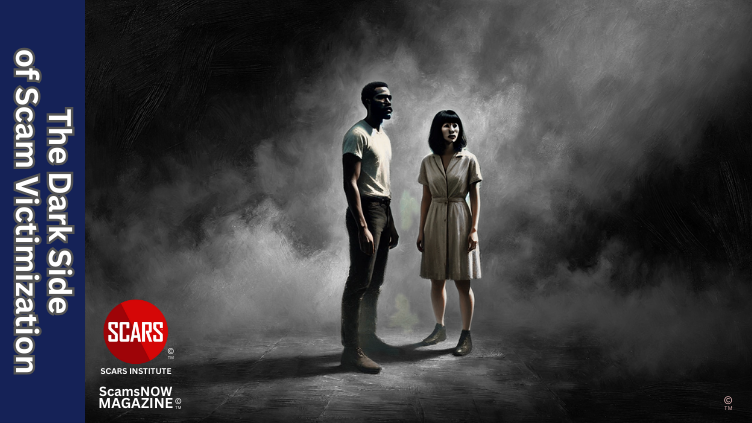
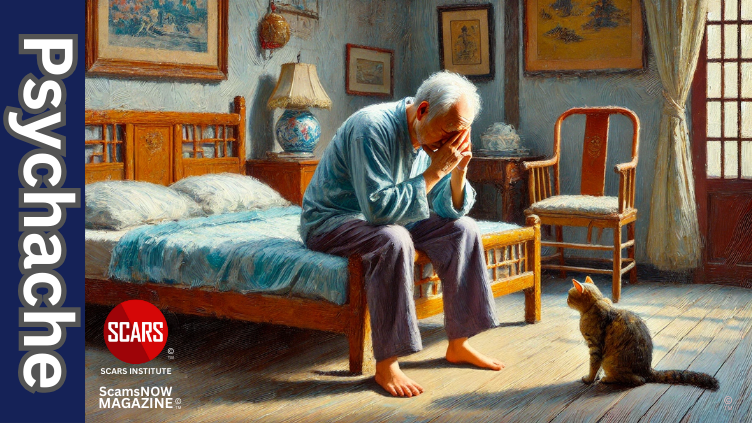
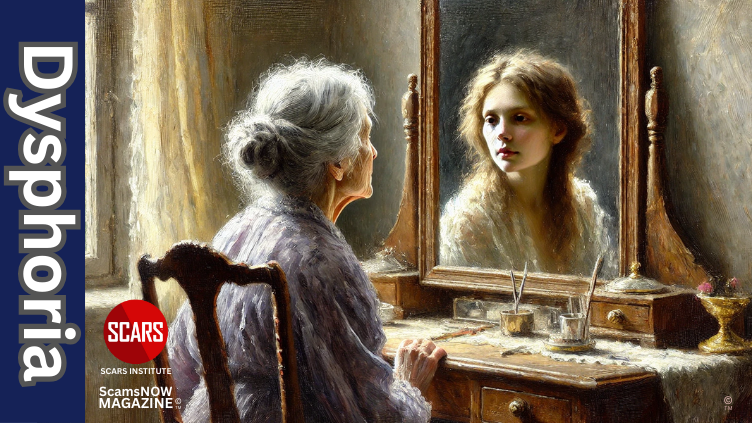
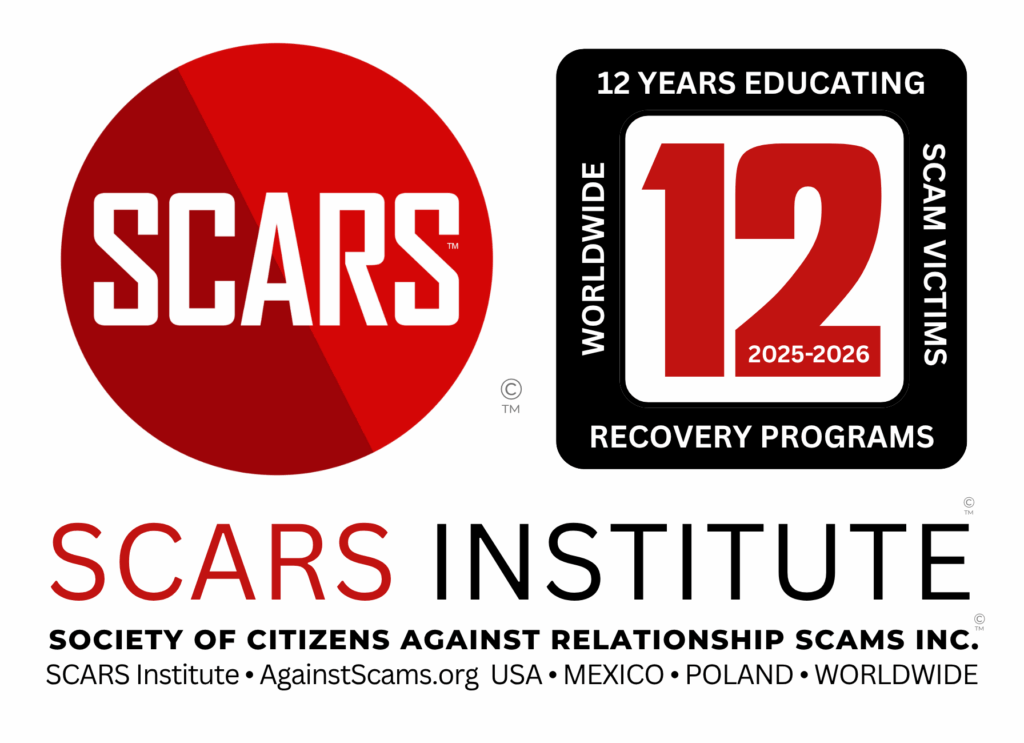

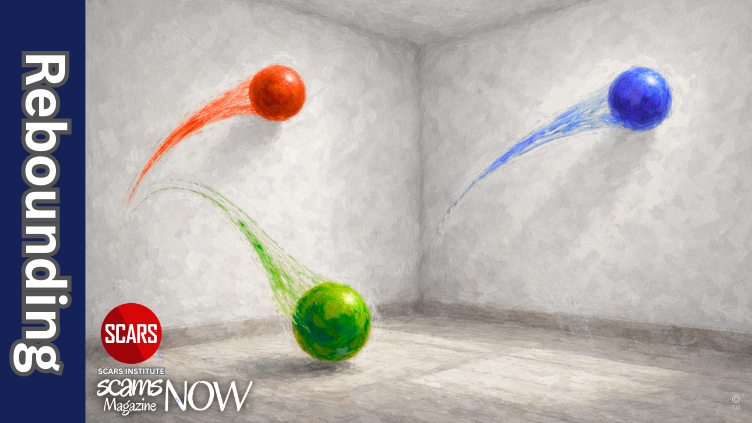


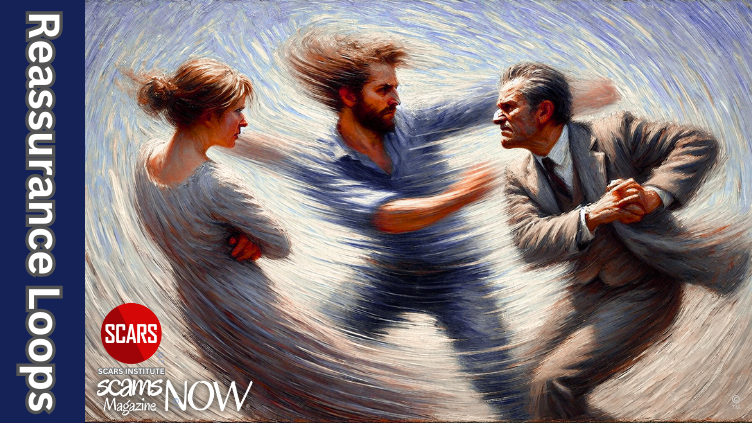

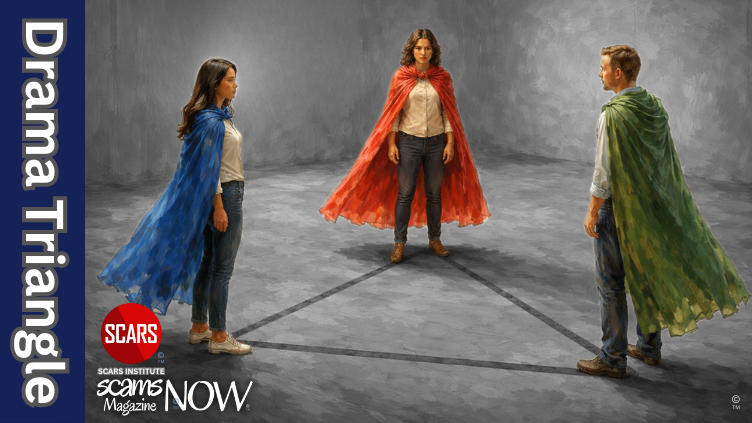


![NavyLogo@4x-81[1] Dysphoria - Wanting Reality to be Different Than It Is - 2025](https://scamsnow.com/wp-content/uploads/2025/04/NavyLogo@4x-811.png)
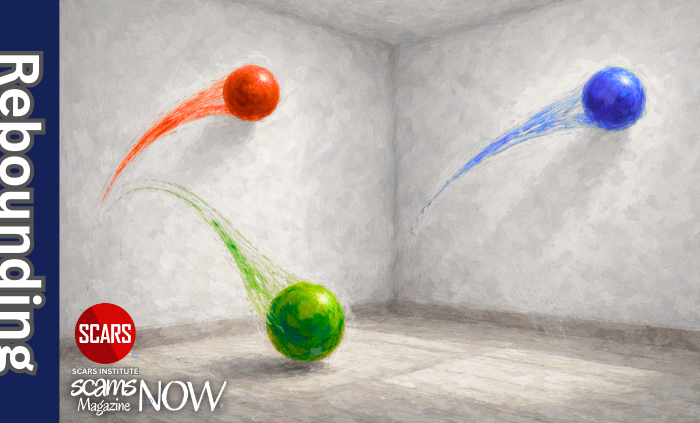

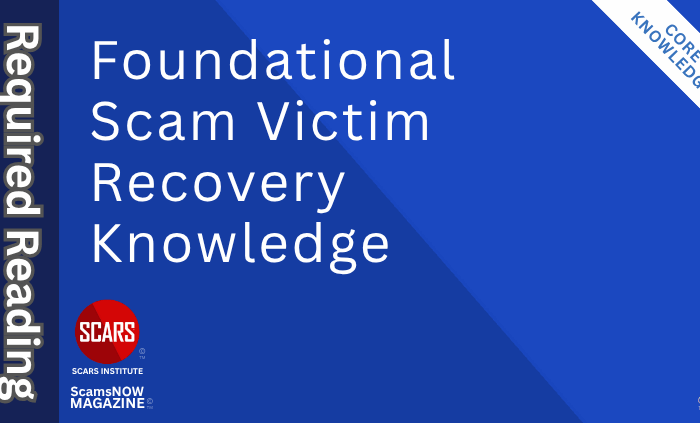

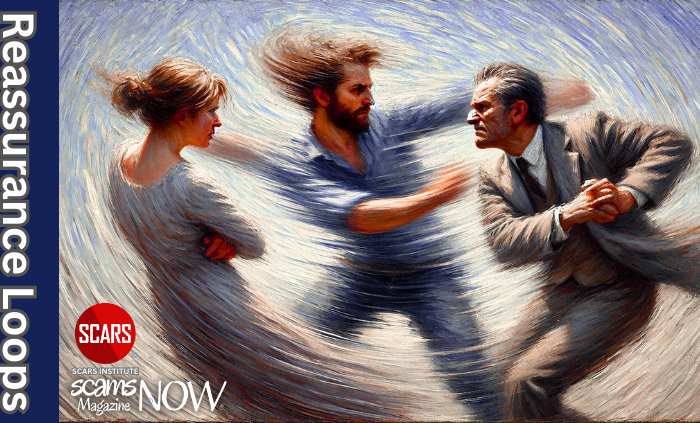




![scars-institute[1] Dysphoria - Wanting Reality to be Different Than It Is - 2025](https://scamsnow.com/wp-content/uploads/2025/04/scars-institute1.png)

![niprc1.png1_-150×1501-1[1] Dysphoria - Wanting Reality to be Different Than It Is - 2025](https://scamsnow.com/wp-content/uploads/2025/04/niprc1.png1_-150x1501-11.webp)
